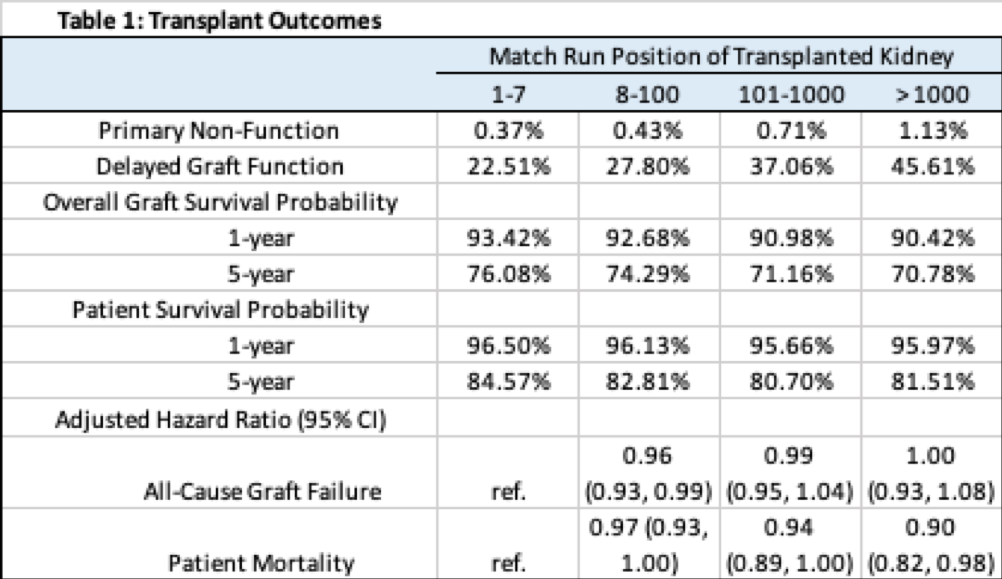UNOS Hard to Place Kidneys: Are We Working Too Hard?
Columbia University, New York, NY
Meeting: 2020 American Transplant Congress
Abstract number: 17
Keywords: Allocation, Graft survival, Kidney transplantation, Waiting lists
Session Information
Session Name: Kidney Deceased Donor Allocation I
Session Type: Oral Abstract Session
Date: Saturday, May 30, 2020
Session Time: 3:15pm-4:45pm
 Presentation Time: 4:15pm-4:27pm
Presentation Time: 4:15pm-4:27pm
Location: Virtual
*Purpose: Kidneys requiring more than 100 offers before acceptance are defined by UNOS as “hard to place,” but many are suitable for transplantation. We sought to determine whether high placement sequence number was associated with inferior graft and patient survival compared to organs placed earlier in the match run.
*Methods: We performed a retrospective analysis using UNOS Potential Transplant Recipient and Standard Transplant and Research data (2008-2015). We excluded kidneys used in multi-organ transplants or pediatric recipients. Match run sequence number for each transplanted kidney was calculated after excluding the systematic/administrative bypasses. Four groups were defined based on placement in match run: 1) 1-7, 2) 8-100, 3) 101-1000, and 4) >1001. Survival analysis was used to compare post-transplant graft and patient survival after adjusting for other markers of organ quality and recipient characteristics. Statistical significance was calculated using logrank and chi-squared tests.
*Results: A total of 78,940 adult deceased donor kidney-only transplants from 2008-2015 were included: 45,096, 23,889, 7,289, and 2,666 respectively in groups 1 through 4. Organs transplanted with higher sequence number had higher KDRI, 1.12 v 1.25 v 1.40 v 1.39 (p<0.0001), and longer cold ischemia time, 14 v 17 v 23 v 32 hrs respectively (p<0.0001). High sequence number recipients tended to be older, have shorter dialysis exposure, and less likely to have a cPRA > 98%. Despite an increased rate of delayed graft function with increasing sequence number group, overall graft and patient survival, at 1- and 5-years post-transplant were comparable between all groups (Table 1). After adjusting for recipient and transplant characteristics, kidneys transplanted at positions >1000 in the match run had comparable graft survival (Hazard Ratio: 1.00, 95% confidence interval: 0.93-1.08) and slightly superior overall patient survival (HR: 0.90, 0.82-0.98) compared to kidneys transplanted at positions 1-7.
*Conclusions: Kidneys transplanted at a higher sequence number had similar long-term graft and patient survival compared to kidneys allocated earlier in the match run, suggesting that many earlier offer refusals for these organs were inappropriate.
To cite this abstract in AMA style:
Chaudhry S, King KL, Husain SA, Cohen D, Ratner L, Mohan S. UNOS Hard to Place Kidneys: Are We Working Too Hard? [abstract]. Am J Transplant. 2020; 20 (suppl 3). https://atcmeetingabstracts.com/abstract/unos-hard-to-place-kidneys-are-we-working-too-hard/. Accessed January 4, 2026.« Back to 2020 American Transplant Congress

